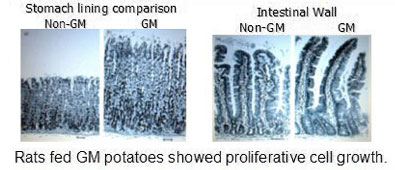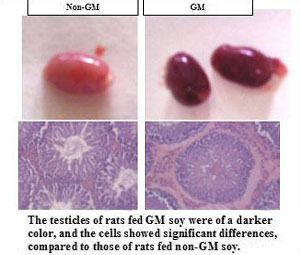Genetically Modified Foods: Toxins and Reproductive Failures
By Jeffrey M. Smith
August 2007
Rhetoric from Washington since the early 1990s proclaims that genetically modified (GM) foods are no different from their natural counterparts that have existed for centuries. But this is a political, not a scientific assertion. Numerous scientists at the FDA consistently described these newly introduced gene-spliced foods as cause for concern. In addition to their potential to produce hard-to-detect allergies and nutritional problems, the scientists said that "The possibility of unexpected, accidental changes in genetically engineered plants" might produce "unexpected high concentrations of plant toxicants."[1] GM crops, they said, might have R 20;Increased levels of known naturally occurring toxins, . . . appearance of new, not previously identified" toxins, and an increased tendency to gather "toxic substances from the environment" such as "pesticides or heavy metals." They recommended testing every GM food "before it enters the marketplace."[2] But the FDA was under orders from the first Bush White House to promote the biotechnology industry, and the political appointee in charge of agency policy was Monsanto's former attorney—later their vice president. The FDA policy ignored the scientists' warnings and allowed GM food crops onto the market without any required safety studies.
From the few safety tests that have been conducted, the results are disturbing—lab animals fed GM diets show damage to virtually every system studied. Reports from farmers are even less encouraging—thousands of sick, sterile and dead animals are traced to GM feed.[3]
GM diet shows toxic reactions in digestive tract
The very first crop submitted to the FDA's voluntary consultation process, the FlavrSavr tomato, showed evidence of toxins. Out of 20 female rats fed the GM tomato, 7 developed stomach lesions.[4] The director of FDA's Office of Special Research Skills wrote that the tomatoes did not demonstrate a "reasonable certainty of no harm,"[5] which is their normal standard of safety. The Additives Evaluation Br anch agreed that "unresolved questions still remain."[6] The political appointees, however, did not require that the tomato be withdrawn.[*]
According to Arpad Pusztai, PhD, one of the world's leading experts in GM food safety assessments, the type of stomach lesions linked to the tomatoes "could lead to life-endangering hemorrhage, particularly in the elderly who use aspirin to prevent [blood clots]."[7] Pusztai believes that the digestive tract should be the first target of GM food risk assessment, because the gut is the first (and largest) point of contact with the foods; it can reveal various reactions to toxins. He was upset, however, that the research on the FlavrSavr never looked passed the stomach to the intestines. Other studies that did look found problems.
Mice were fed potatoes with an added bacterial gene, which produced an insecticide called Bt-toxin. Scientists analyzed the lower part of their small intestines (ileum) and found abnormal and damaged cells, as well as proliferative cell growth.[8] Rats fed potatoes engineered to produce a different type of insecticide (GNA lectin from the snowdrop plant) also showed proliferative cell growth in both the stomach and intestinal walls. [9] Although the guts of rats fed GM peas were not examined for cell growth, the intestines were mysteriously heavier; possibly resulting from such growth.[10] Cell proliferation can be a precursor to cancer and is of special concern.
GM diets cause liver damage
The state of the liver—a main detoxifier for the body—is another indicator of toxins.
Rats fed the GNA lectin potatoes described above had smaller and partially atrophied livers.[11] Rats fed Monsanto's Mon 863 corn, engineered to produce Bt-toxin, had liver lesions and other indications of toxicity.[12] Rabbits fed GM soy showed altered enzyme production in their livers as well as higher metabolic activity.[13] The livers of rats fed Roundup Ready canola were 12%–16% heavier, possibly due to liver disease or inflammation.[14] And microscopic analysis of the livers of mice fed Roundup Ready soybeans revealed altered gene expression and structural and functional changes.[15] Many of these changes reversed after the mice diet was switched to non-GM soy, indicating that GM soy was the culprit. The findings, according to molecular geneticist Michael Antoniou, PhD, "are not random and must reflect some 'insult' on the liver by the GM soy." Antoniou, who does human gene therapy research in King's College London, said that although the long-term consequences of the GM soy diet are not known, it "could lead to liver damage and consequently general toxemia."[16]
Higher death rates and organ damage
Some studies showed higher death rates in GM-fed animals. In the FlavrSavr tomato study, for example, a note in the appendix indicated that 7 of 40 rats died within two weeks and were replaced.[17] In another study, chickens fed the herbicide tolerant "Liberty Link" corn died at twice the rate of those fed natural corn.[18] But in these two industry-funded studies, the deaths were dismissed without ade quate explanation or follow-up.
In addition, the cells in the pancreas of mice fed Roundup Ready soy had profound changes and produced significantly less digestive enzymes;[19] in rats fed a GM potato, the pancreas was enlarged.[20] In various analyses of kidneys, GM-fed animals showed lesions, toxicity, altered enzyme production or inflammation. Enzyme production in the hearts of mice was altered by GM soy.[21] And GM potatoes caused slower growth in the brain of rats.[22]
Reproductive failures and infant mortality
In both mice and rats fed Roundup Ready soybeans, their testicles showed dramatic changes. In rats, the organs were dark blue instead of pink.[23] In mice, young sperm cells were altered.[24] Embryos of GM soy-fed mice also showed temporary changes in their DNA function, compared to those whose parents were fed non-GM soy.[25]
More dramatic results were discovered by a leading scientist at the Russian National Academy of sciences. Female rats were fed GM soy, starting two weeks before they were mated.
Over a series of three experiments, 51.6 percent of the offspring from the GM-fed group died within the first three weeks, compared to 10 percent from the non-GM soy group, and 8.1 percent for non-soy controls. "High pup mortality was characteristic of every litter from mothers fed the GM soy flour."[26] The average size and weight of the GM-fed offspring was quite a bit smaller.[27] In a preliminary study, the GM-fed offspring were unable to conceive.[28] After the three feeding trials, the supplier of rat food used at the Russian laboratory began using GM soy in their formulation. Since all the rats housed at the facility were now eating GM soy, no non-GM fed controls were available for subsequent GM feeding trials; follow-up studies were canceled. After two months on the GM soy diet, however, the infant mortality rate of rats throughout the facility had skyrocketed to 55.3 percent (99 of 179).[29]
Farmers report livestock sterility and deaths
About two dozen farmers reported that thousands of their pigs had reproductive problems when fed certain varieties of Bt corn. Pigs were sterile, had false pregnancies, or gave birth to bags of water. Some cows and bulls also became sterile. Bt corn was also implicated by farmers in the deaths of cows, horses, water buffaloes, and chickens. [30]
When Indian shepherds let their sheep graze continuously on Bt cotton plants, within 5-7 days, one out of four sheep died. There was an estimated 10,000 sheep deaths in the region in 2006, with more reported in 2007. Post mortems on the sheep showed severe irritation and black patches in both intestines and liver (as well as enlarged bile ducts). Investigators said preliminary evidence "strongly suggests that the sheep mortality was due to a toxin. . . . most probably Bt-toxin."[31]
Dangerous denial
The warnings of the FDA scientists appear to have come true. But we were not supposed to know about their concerns. The agency's internal memos were only made public due to a lawsuit. Instead, we were supposed to believe the official FDA policy, claiming that the agency is not aware of information showing that GM foods are meaningfully different. This statement, crafted by political appointees, directly contradicts the scientific consensus at the FDA.
Nearly every independent animal feeding safety study on GM foods shows adverse or unexplained effects. But we were not supposed to know about these problems either—the biotech industry works overtime to try to hide them. Industry studies described above, for example, are neither peer-reviewed nor published. It took lawsuits to make two of them available. And adverse findings by independent scientists are often suppressed, ignored, or denied. Moreover, researchers that discover problems from GM foods have been fired, stripped of responsibilities, deprived of tenure, and even threatened. The myth that GM crops are the same safe food we have always eaten continues to circulate.
With the overwhelming evidence of problems since their introduction in 1996, however, it is likely that GM foods are contributing to the deterioration of health in the United States. Without human clinical trials or post-marketing surveillance, we can't tell which worsening health statistic may be due to these foods. But we also can't afford to wait until we find out. GM foods must be removed from our diet immediately. Fortunately, more and more people are making healthy non-GM choices for themselves and their family. To learn which foods are genetically modified and how to protect yourself, visit www.GeneticRoulette.com.
[*] Calgene had submitted data on two lines of GM tomatoes, both using the same inserted gene. They voluntarily elected to market only the variety that was not associated with the lesions. This was not required by the FDA, which did not block approvals on the lesion-associated variety. The FlavrSavr tomato has since been taken off the market. After the FlavrSavr, no other biotech company has submitted such detailed data to the FDA. And the superficial summaries they do present to the agency are dismissed by critics as woefully inadequate to judge safety.
References available on request



